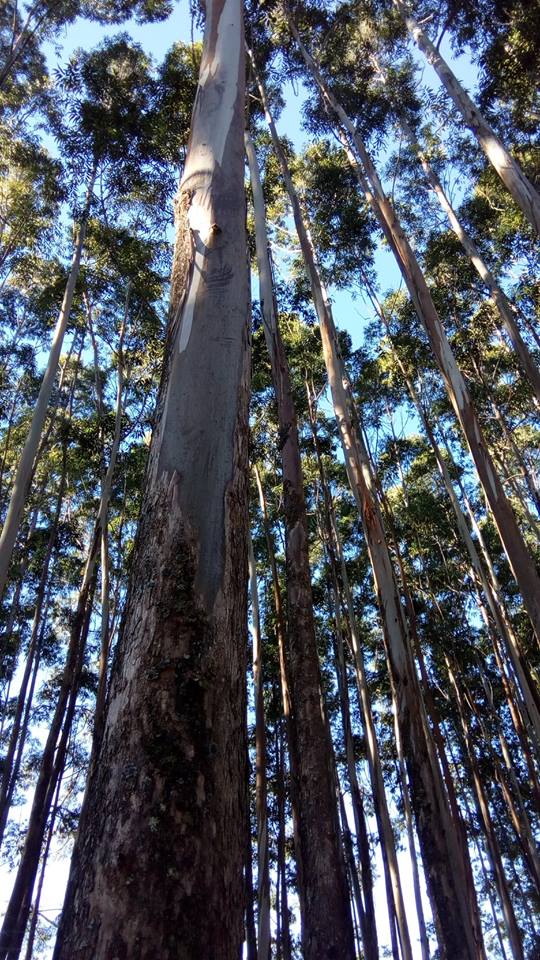JB Friday, Extension Forester over at the College of Tropical Agriculture and Human Resources, has given advice about forestry options for these plantation crops when they first began planting in the 90s. I was able to speak with him via phone Friday with regards to these large Eucalyptus plantations and here’s my notes from that conversation:
The majority of the plantation trees along Hamakua coast are Eucalyptus grandis, along with E. saligna, planted mainly for other uses prior to the massive crops. E. grandis and saligna are very similar, both good wood suitable for many options, including furniture, flooring, structural, veneer and ply purposes.
The problem with harvesting these trees for such uses is the mill and economy of scale with the manufacturing process. The Big Island doesn’t have a mill big enough to compete with economies of scale that similar products would benefit from in pricing at Home Depot, etc. Our local hardwood mills stick to high value lumber like koa to turn a profit. There have been various ideas proposed for uses of the trees, one was the Tradewinds veneer project a few years ago, and from 2012 thru 2016 we were exporting them to China for veneer and other uses, but a drop in market, and now the current administrations tariffs with China, make that option unfeasible. It’s too expensive for Hawaii to ship out, mill, and ship back, so currently we continue to simply import wood from elsewhere, as only people with “locally grown” interests are willing to the extra to mill here. Lots of uses could happen if economic factors shifted and the forests were properly managed with selective harvesting. That means lots of jobs. However, JB was clear. Burning is certainly the lowest value use of these trees.
*Note: JB himself has wood flooring in his home made of the eucalyptus.
In retrospect it would have been better if the large landowners (Kamehameha Schools) had planted native Koa or other high value timber (I think JB mentioned that back in the day), like the tabled proposal to plant 10 % mahogany. But one option now might be if county/landowners would lease out more acreages to forest, making a supply large enough to build a large mill (I get the sense JB likes trees and planting them, totally with him there). A cost benefit analysis of this would point us in the right direction with a large mill. However Kam Schools recently announced wanting to reduce their forestry holdings (along that request for proposals of what to do) so these ideas may be heading in different directions. https://www.hawaiitribune-herald.com/2018/10/15/hawaii-news/search-is-on-for-new-operator-to-harvest-eucalyptus/ So what to do with this information?
We can understand how Kam schools would be having trouble with these issues, due to the size of their landholdings it may be hard finding satisfactory industrial level projects. With thousands of acres a plot, ranching or forestry are easier options than small scale vegetables or diversified ag. Personally I find that really frustrating and think there should be solutions on the table for this, but of the given large scale options it seems pretty clear forestry (without burning) is the most dynamic solution to our climate crisis, island water and endangered species concerns, as well as long term resource and job creation. Our naive suggestion: plant more natives and use the talked about big tax credits for Hu Honua instead to help investments in many small scale mills, enough to have various products and job opportunities in different locations. Waive the general excise tax on locally sourced and produced wood products, and find other ways to incentivize this market to grow.
However, back to the info: Currently there is the potential for a carbon credits, the Dept. of Forestry and Wildlife is talking about this for other holdings. not sure if this has been explored for the Kam school trees in particular. Preferable to many progressive environmentalists would be a carbon tax, as it would ensure projects like Hu Honua would pay fairly for what comes out of the smokestack locally and more clearly link it to community concerns, rather than simply shifting the accounting around. Either way the encouragement to plant trees and work on local solutions to climate change seems like a win win situation. One major issue with harvesting is the below ground carbon, and how to properly account for that in the market/credits,.
With these trees and Bioenergy, there is a break even point at some point (usually within 100 years as new trees planted soak up the additional carbon output), but we the public need to see the study of this for our local conditions, I mentioned to JB the Greenhouse Gas calculator I found from Canada government, but he said there’s lots of major factors at play here, transport distance is a big issue, terrain (Hamakua coast has a lot of steep slopes) Gas costs in Canada vs Hawaii, differences of soil carbon rates according to type/flora etc. We have yet to see the data from Hu Honua on their claims to be “green” much less carbon neutral. Also, the intent in planting the trees needs to be put in the equation, harvesting existing trees vs. planting new trees. These trees were planted to chip for paper or other markets, but not to burn. I’m wondering what is the accounting on that? Where are the commitments not to ship in material from afar as trees regrow? And most importantly, where are the commitments to regrow the trees, especially if Kam schools is trying to get out of the forestry game? Given the information we have so far, this does not look like long term planning and jobs. We need more info.




Leave a Reply